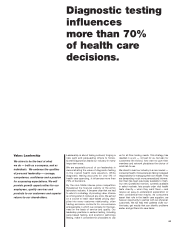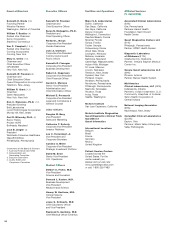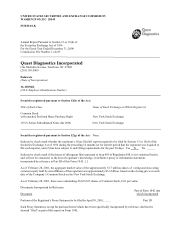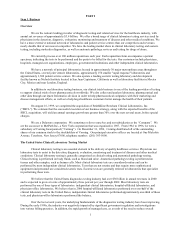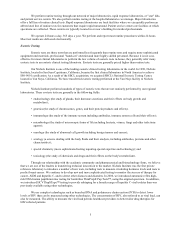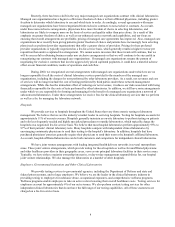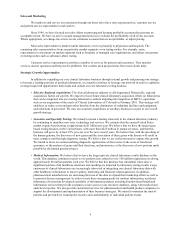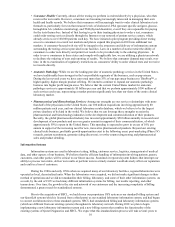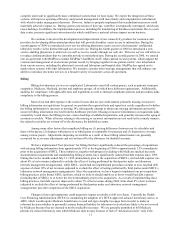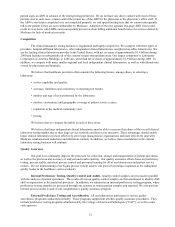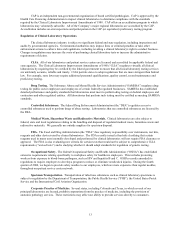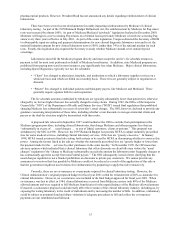Quest Diagnostics 2000 Annual Report Download - page 25
Download and view the complete annual report
Please find page 25 of the 2000 Quest Diagnostics annual report below. You can navigate through the pages in the report by either clicking on the pages listed below, or by using the keyword search tool below to find specific information within the annual report.5
We perform routine testing through our network of major laboratories, rapid response laboratories, or "stat" labs,
and patient service centers. We also perform routine testing at the hospital laboratories we manage. Major laboratories
offer a full line of routine clinical tests. Rapid response laboratories are local facilities where we can quickly perform an
abbreviated line of routine tests for customers that require rapid turnaround. Patient service centers are facilities at which
specimens are collected. These centers are typically located in or near a building for medical professionals.
We operate 24 hours a day, 365 days a year. We perform and report most routine procedures within 24 hours.
Most test results are delivered electronically.
Esoteric Testing
Esoteric tests are those tests that are performed less frequently than routine tests and require more sophisticated
equipment and materials, professional "hands-on" attention and more highly skilled personnel. Because it is not cost-
effective for most clinical laboratories to perform the low volume of esoteric tests in-house, they generally refer many
esoteric tests to an esoteric clinical testing laboratory. Esoteric tests are generally priced higher than routine tests.
Our Nichols Institute is one of the leading esoteric clinical testing laboratories in the world. In 1998, Nichols
Institute, located in San Juan Capistrano, California, became the first clinical laboratory in North America to achieve
ISO-9001 certification. As a result of the SBCL acquisition, we acquired SBCL's National Esoteric Testing Center,
located in Van Nuys, California. We have transferred esoteric testing performed at the Van Nuys facility to Nichols
Institute.
Nichols Institute performs hundreds of types of esoteric tests that are not routinely performed by our regional
laboratories. These esoteric tests are generally in the following fields:
• endocrinology (the study of glands, their hormone secretions and their effects on body growth and
metabolism);
• genetics (the study of chromosomes, genes, and their protein products and effects);
• immunology (the study of the immune system including antibodies, immune system cells and their effects);
• microbiology (the study of microscopic forms of life including bacteria, viruses, fungi and other infectious
agents);
• oncology (the study of abnormal cell growth including benign tumors and cancer);
• serology (a science dealing with the body fluids and their analysis, including antibodies, proteins and other
characteristics);
• special chemistry (more sophisticated testing requiring special expertise and technology); and
• toxicology (the study of chemicals and drugs and their effects on the body's metabolism).
Through our relationship with the academic community and pharmaceutical and biotechnology firms, we believe
that we are one of the leaders in transferring technical innovation to the market. Nichols Institute was the first private
reference laboratory to introduce a number of new tests, including tests to measure circulating hormone levels and tests to
predict breast cancer. We continue to develop new and more sophisticated testing to monitor the success of therapy for
cancer, AIDS and hepatitis C, and to detect other diseases and disorders. In 2000, we introduced automatic reflex high-
risk DNA human papillomavirus testing for borderline ThinPrep® Pap Tests™, using the original specimen. In addition,
we introduced HCV DupliType™ testing to provide subtyping for a broader range of hepatitis C viral isolates than was
previously available using other technologies.
We use complex technologies such as branched DNA and polymerase chain reaction (PCR) to detect lower
levels of HIV than can be measured using other technologies. The concentration of HIV, also referred to as viral load, can
also be measured. The ability to measure the viral load permits healthcare providers to better tailor drug therapies for
HIV-infected patients.




